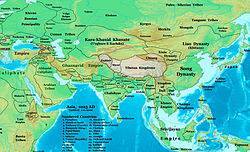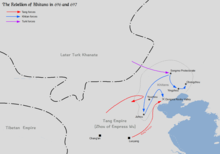
The Five Dynasties and Ten Kingdoms period was an era of political upheaval and division in Imperial China from 907 to 979. Five dynastic states quickly succeeded one another in the Central Plain, and more than a dozen concurrent dynastic states, collectively known as the Ten Kingdoms, were established elsewhere, mainly in South China. It was a prolonged period of multiple political divisions in Chinese imperial history.
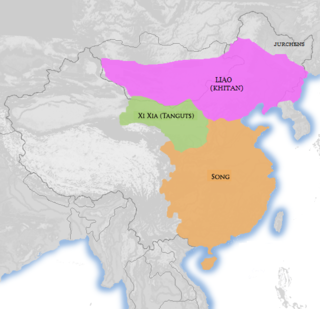
The Western Xia or the Xi Xia (Chinese: 西夏; pinyin: Xī Xià; Wade–Giles: Hsi1 Hsia4), officially the Great Xia (大夏; Dà Xià; Ta4 Hsia4), also known as the Tangut Empire, and known as Mi-nyak to the Tanguts and Tibetans, was a Tangut-led Buddhist imperial dynasty of China that existed from 1038 to 1227. At its peak, the dynasty ruled over modern-day northwestern China, including parts of Ningxia, Gansu, eastern Qinghai, northern Shaanxi, northeastern Xinjiang, and southwest Inner Mongolia, and southernmost Outer Mongolia, measuring about 800,000 square kilometres (310,000 square miles).

Balhae or Jin, also rendered as Bohai, was a multi-ethnic kingdom established in 698 by Dae Joyeong and originally known as the Kingdom of Jin until 713 when its name was changed to Balhae. At its greatest extent it corresponded to what is today Northeast China, the northern half of the Korean Peninsula and the southeastern Russian Far East.

The An Lushan rebellion was an eight-year civil war during the mid-point of the Tang dynasty that started as a commandery rebellion, attempting to overthrow and replace the Imperial Government with the rogue Yan dynasty. The rebels succeeded in capturing the imperial capital Chang'an after the emperor had fled to Sichuan, but eventually succumbed to internal divisions and counter-attacks by the Tang and their allies. The rebellion spanned the reigns of three Tang emperors.
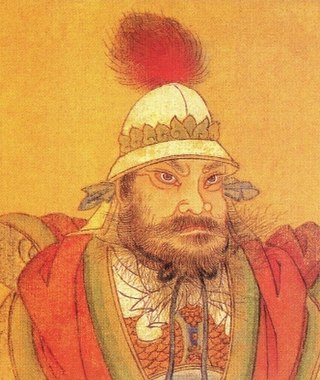
An Lushan was a general in the Tang dynasty and is primarily known for instigating the An Lushan Rebellion.

Shiwei were a Mongolic people that inhabited far-eastern Mongolia, northern Inner Mongolia, northern Manchuria and the area near the Okhotsk Sea beach. Records mentioning the Shiwei were recorded from the time of the Northern Wei (386–534) until the rise of the Mongols under Genghis Khan in 1206 when the name "Mongol" and "Tatar" were applied to all the Shiwei tribes.

The Sixteen Prefectures of Yanyun comprise a historical region in northern China along the Great Wall in present-day Beijing, Tianjin, and part of northern Hebei and Shanxi. It was a site of constant military and political conflict between various dynasties from the end of the Tang dynasty until the establishment of the Yuan dynasty.

The Shatuo, or the Shatuo Turks were a Turkic tribe that heavily influenced northern Chinese politics from the late ninth century through the tenth century. They are noted for founding three, Later Tang, Later Jin, and Later Han, of the five dynasties and one, Northern Han, of the ten kingdoms during the Five Dynasties and Ten Kingdoms period. The Northern Han would later be conquered by the Song dynasty. Sometime before the 12th century, the Shatuo disappeared as a distinct ethnic group, many of them having become acculturated and assimilating into the general population around them.
Wang Xiaojie (王孝傑), formally the Duke of Geng (耿國公), was a Chinese military general and politician of the Chinese Tang dynasty and Wu Zetian's Zhou dynasty, serving in campaigns against Tibet, Eastern Turks, and Khitan and briefly serving as chancellor during Wu Zetian's reign. He was killed in 697 in a battle against Khitan's khan Sun Wanrong.
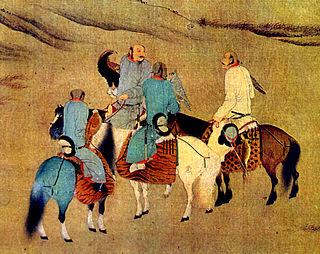
The Khitan people were a historical nomadic people from Northeast Asia who, from the 4th century, inhabited an area corresponding to parts of modern Mongolia, Northeast China and the Russian Far East.
The Kumo Xi, also known as the Tatabi, were ancient steppe people located in current Northeast China from 207 CE to 907 CE. After the death of their ancestor Tadun in 207, they were no longer called Wuhuan but joined the Khitan Xianbei in submitting to the Yuwen Xianbei. Their history is widely linked to the more famous Khitan.
Ketuyu was a Khitan military chief, notable for his Ketuyu rebellion. Despite the presence of a khagan, he de facto controlled Khitan politics. His power made the Khitan khagan jealous, and he then defended himself by making a coup in 720, against Li Shaogu(李邵固). By this action, he incurred Tang dynasty opposition and they sent military campaigns against him, which he defeated several times. He was eventually crushed by repeated Tang campaigns, and was murdered together with Wa khaghan(洼可汗) Yaonian Qulie(遙輦屈列) by his subordinate Li Guozhe(李過折).
The History of Liao, or Liao Shi, is a Chinese historical book compiled officially by the Mongol-led Yuan dynasty (1271–1368), under the direction of the historian Toqto'a (Tuotuo), and finalized in 1344. Based on Khitan's primary sources and other previous official Chinese records, it details the Khitan people, Khitan's tribal life and traditions, as well as the official histories of the Liao dynasty and its successor, the Western Liao dynasty.
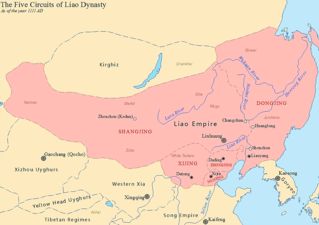
The Liao dynasty, also known as the Khitan Empire, officially the Great Liao, was an imperial dynasty of China that existed between 916 and 1125, ruled by the Yelü clan of the Khitan people. Founded around the time of the collapse of the Tang dynasty, at its greatest extent it ruled over Northeast China, the Mongolian Plateau, the northern part of the Korean Peninsula, southern portions of the Russian Far East, and the northern tip of the North China Plain.

Nanjing was the name for modern Beijing during the Khitan-led Liao dynasty of China, during which it served as the empire's southern capital. To distinguish "Nanjing" from the modern city of Nanjing in Jiangsu, and Beijing Damingfu, the name for modern Daming County in Hebei Province during the Northern Song dynasty, Chinese historians sometimes refer to Liao-era Beijing as Liao Nanjing. The Liao acquired the city, then known as Youzhou, in the cession of the Sixteen Prefectures in 938 by the Later Jin, one of the five short-lived dynasties that ruled northern China following the end of the Tang dynasty. The city was officially renamed "Nanjing, Youdu Fu" (南京幽都府). In 1012, the city was renamed "Nanjing, Xijin Fu" (南京析津府). The city was also colloquially referred to at the time as "Yanjing". In 1122, the city was captured by the Jurchen-led Jin dynasty (1115–1234)—who officially renamed it "Yanjing", ending the use of "Nanjing" for what is today modern Beijing.

The Tang dynasty of China administered territory using a hierarchical system of three descending divisions: circuits, prefectures, and counties. Prefectures have been called jùn (郡) as well as zhōu (州) interchangeably throughout history, leading to cases of confusion, but in reality their political status was the same. The prefectures were furthered classified as either Upper Prefectures, Middle Prefectures, or Lower Prefectures depending on population. An Upper Prefecture consisted of 40, 000 households and above, a Middle Prefecture 20, 000 households and above, and a Lower Prefecture anything below 20, 000 households. Some prefectures were further categorized as bulwark prefectures, grand prefectures, renowned prefectures, or key prefectures for strategic purposes. A superior prefecture was called a fu (府).

Yōuzhōu Jiédùshǐ (幽州), also known as Yōujì Jiédùshǐ (幽薊), Yānjì Jiédùshǐ (燕薊), Fànyáng Jiédùshǐ (范陽), and Lúlóng Jiédùshǐ (盧龍), was a military district during the Tang dynasty. It covered the area of Yānjì (燕薊) in what is now the Beijing and Hebei region. Youzhou was the base of operations for An Lushan as well as one of the revolting three garrisons of Hebei.

The military history of the Tang dynasty encompasses the period of Chinese military activity from 618 to 907. The Tang dynasty and the preceding Sui dynasty share many similar trends and behaviors in terms of military tactics, strategy, and technology, so it can be viewed that the Tang continued the Sui tradition.

The military history of the Five Dynasties and Ten Kingdoms covers the period of Chinese history from the collapse of the Tang dynasty in 907 to the demise of Northern Han in 979. This period of Chinese history is noteworthy for the introduction of gunpowder weapons and as a transitional phase from the aristocratic imperial system to the Confucian bureaucracy which characterized the Song, Ming, and Qing dynasties.
The Battle of Xiangji Temple was a major battle during the An Lushan rebellion. Tang forces launched the campaign to recapture the Tang dynasty's capital Chang'an from the rebelling Yan dynasty. Tang forces were able to inflict heavy casualties upon the Yan army and force them to retreat, allowing them to recapture Chang'an after the battle. The battle is notable as one of the bloodiest one day battles in history.
